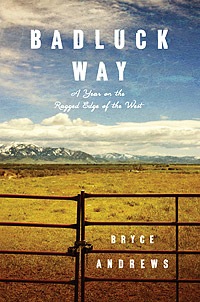 As Bryce Andrews recounts a year spent on the Sun Ranch, an enormous spread that sprawls along the Madison River, his words bristle and glisten, much like the wolves that enthrall the young cowboy.
As Bryce Andrews recounts a year spent on the Sun Ranch, an enormous spread that sprawls along the Madison River, his words bristle and glisten, much like the wolves that enthrall the young cowboy.
“The wolf came up Beaver Creek quiet as fog,” he writes of the enigmatic, ominous predators. “Wolves inhabit a landscape humans can never know. Their forest is different from the one we walk through – more intelligible, bursting at the seams with information.”
Andrews is close behind, trailing the Wedge Pack as it builds a den in Squaw Creek’s “labyrinth of fens and dark timber.” He tunes eyes and ears to the new landscape, exploring meadows, forests and creek beds by foot, horse and four-wheeler. Building fence, splicing wire, filling stock tanks and nursing cattle, he comes to know the ranch and its wild and domesticated inhabitants. “I was living at the center of my heart’s geography. And I knew it,” he writes.
Gradually, the greenhorn from Seattle hardens. The real work of ranching, he discovers, “is the process of toughening the body into something worn, weathered, scarred, and strong enough to do everything asked of it.”
Andrews, the son of a Seattle photographer and an art director, got his first taste for “big, dry, lonely country” as seven year old, when the family visited sculptor Pat Zentz on his ranch near Billings. He returned summer after summer, learning enough skills to apply for the job at the Sun,
The ranch’s wealthy owner was committed to running a spread where human and animal interactions were “carefully choreographed to complement, rather than hinder, the systems of the wild.” And wild it was, perched near Yellowstone Park and the boundary of the Lee Metcalf Wilderness, with more 2,000 elk, plus deer, antelope and a handful of grizzlies also calling it their summer home.
But it’s the wolves that add grit and complexity to the story. As Andrews and his compatriots drive cattle higher into the hills, wolves begin to attack the livestock. Andrews finds himself “stuck between my love of wild things and rage at the ruin of a summer’s work.”
By late July, with four heifers dead, he joins the hunt, and shoots the pack leader – an event that haunts him. “I couldn’t help thinking about the fact that I had taken something that floated through the forest like a spirit, and reduced it to dead weight and fecal smell.”
After his year at the Sun, Andrews earned a master’s degree in environmental studies, and has gone on to manage and help restore several Montana ranches.
“One could find no better guide than Bryce Andrews for a journey along the shifting border between the wild and the tame; a daunting frontier filled with unsettling truths, blood and beauty,” writes columnist David Horsey in the Los Angeles Times.
– Kristi Niemeyer